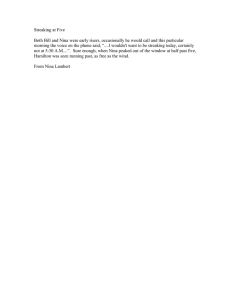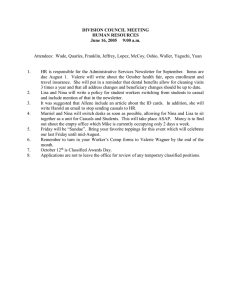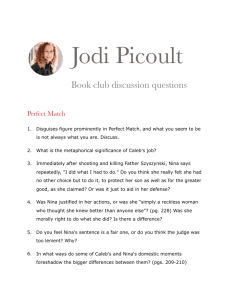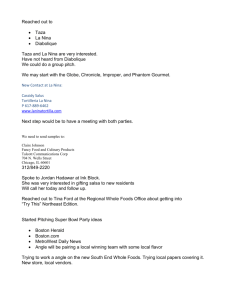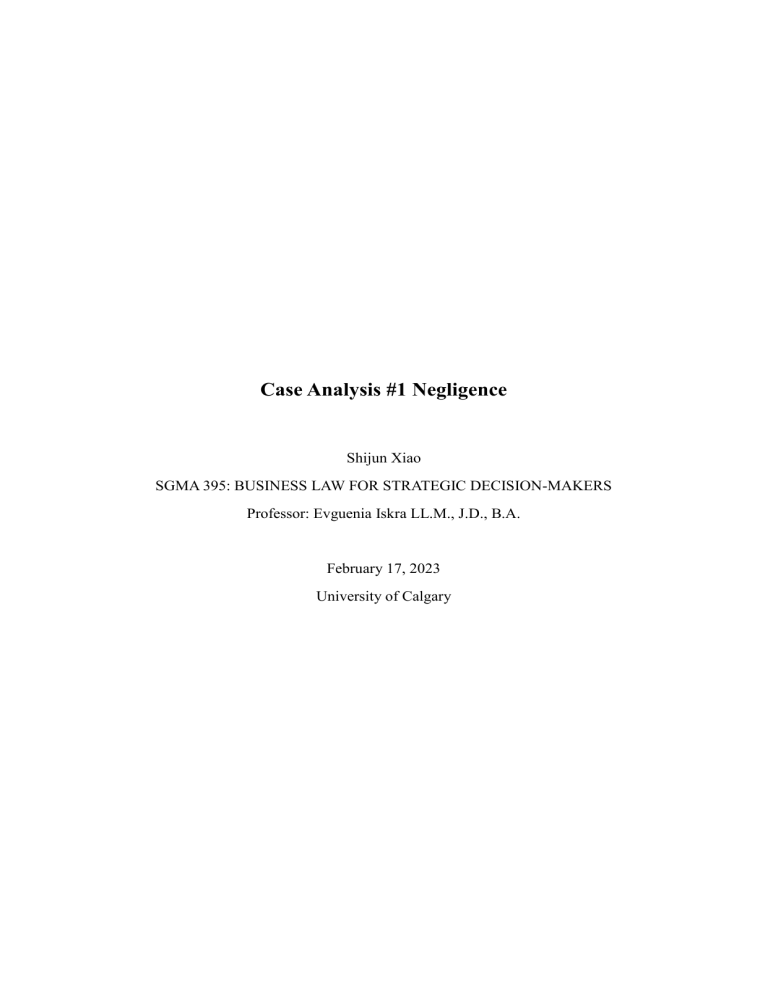
Case Analysis #1 Negligence Shijun Xiao SGMA 395: BUSINESS LAW FOR STRATEGIC DECISION-MAKERS Professor: Evguenia Iskra LL.M., J.D., B.A. February 17, 2023 University of Calgary Analyze Nina's claim and any defenses the department store has. Where (level of court & city) would she file the Civil Claim, and why? (50-75 words5 points) Answer: Calgary is part of Alberta, for the Civil Claim, according to the provisions of limited jurisdiction, if the claims are under $50,000, the plaintiff will file a Civil Claim In the Alberta Provincial Court, for claims above $50,000, the plaintiff will file a Civil Claim In the Court of Queen's Bench of Alberta. Nina estimated claim amount is between $30,000 and $35,000.00, so she will file the Civil Claim In the Alberta Provincial Court. 2. What document will the defendant file with the court in response to the Civil Claim? (1 point) Answer: If disputing, the defendant will prepare a defense. Defense is The defendant's formal response to the plaintiff's allegations. In the Provincial Court of Alberta, the document is called a Dispute Note, in the Court of Queen's Bench the document is called a Statement of Defence. Statement of Defence. 3. Analyze Nina's negligence claim and assess her likelihood of success. Negligence is the legal cause of action arising from harming another person unintentionally negligence is the legal cause of action arising from unintentionally harming another person. 1 To determine whether the large high-end department store in Calgary was negligent in customer shopping, the plaintiff must prove all the elements: duty of care, the standard of care, causation, & damages. 1 Iskra, Evguenia. Module 2 Part 4 ABCD’s of Negligence Recording. Vol. 4. 5 vols. Module 2: Torts. Accessed Feburary 18, 2023.https://d2l.ucalgary.ca/d2l/le/content/497036/Home 1 (1) Summary of facts On January 3, Nina, a 5ft, the not very fit, but very successful 34-year-old dentist was shopping at a large high-end department store in Calgary. As she walked through the store in the shoe aisle, she noticed the floor was wet and reminded the salesman should set up signs on wet floors. Then, as she moved to the aisle with the jackets and coats, while talking on the phone, she reached for a coat on the highest level with her free hand. She fell and broke her ankle, However, there was a sign warning customers to seek assistance with items on the shelves. Nina decides to file a Civil Claim and sue the department store for pain and suffering, loss of Nina decides to file Civil Claim and sue the department store for pain and suffering, loss of amenities, and enjoyment of life to be between $30,000 and $35,000. (2) Duty of care The duty of care is the legal duty to avoid causing harm to others through negligence. The duty is to take reasonable care to avoid foreseeable harm to a person with whom one has an intimate relationship. Depending on the relationship between the parties, the defendant must have a legal duty to take reasonable care of the plaintiff. For example, a doctor must provide a certain level of care to a patient, or a landlord has to keep his premises in a reasonably safe condition for visitors. Nina was buying a new winter coat and sneakers at a large, high-end department store in Calgary, and she was a customer of the department store, so in this case, the large, high-end department store had a legal obligation to look after Nina because they were the owner, operator, and maintainer of the store. A customer bought some ice cream and an opaque bottle of ginger beer for her friend Donoghue. Some of the ginger beer was poured over the ice cream, and some were drunk by Donoghue. When the rest of the beer was poured into the saucepan, a rotting snail was found inside. Donoghue became ill and subsequently sued the manufacturer for damages on the grounds of negligence. Because of Donoghue's case, the law on negligence - especially in the context of a duty of care - has become increasingly complex, as the following discussion illustrates. However, as the Supreme Court of Canada recently confirmed, Donohue remains a 2 cornerstone.2 There are a common law and statutory duties of care. In this case, the department store in Calgary owes a statutory duty of care. The department store does have a duty of care because they are the owners, operate the property and set the rules for the public area. 3 In this case, Nina was a visitor and “visitor” means: (i) an entrant as of right, (ii) a person who is lawfully present on premises by virtue of an express or implied term of a contract, (iii) any other person whose presence on premises is lawful, or (iv) a person whose presence on premises becomes unlawful after the person’s entry on those premises and who is taking reasonable steps to leave those premises.4 (3) Standard of care The standard of care refers to the defendant's conduct in fulfilling his or her duty of care. The court must determine whether the defendant failed to act reasonably in breach of his or her duty of care, thereby creating a risk of harm to the plaintiff. This may involve acting or failing to act, and the standard of care used to determine whether a breach occurred will vary from case to case. In this case, as Nina walked through the shoe store aisle, she noticed the floor was wet and alerted the sales associate that a sign should be placed on the wet floor, the employee said it was a known problem and was awaiting repair, thanking her for the tip to post another sign. This shows that the department store's attention to standards is flawed and that customers are likely to accidentally slip and fall because they are not prompted by a sign. Later Nina slipped and broke her ankle while reaching for her coat on the highest shelf. Although 2 Rankin(Rankin’s Garage & Sales)v.JJ.2018 SCC10. 3 Province of Alberta. “Occupiers’ Liability Act.” Alberta Queen’s Printer. Accessed February 19,2023. https://www.qp.alberta.ca/documents/acts/o04.pdf. 4 RSA 1980 cO-3 s1 3 there is a sign warning customers to seek help in reaching for items on the shelves, not all customers may notice the sign in time, and it may not be obvious or convenient to get help, which also shows that the department store's standard of care is unreasonable and inadequate. (4) Causation Plaintiffs must prove that the defendant's negligence caused or contributed to the injuries they suffered. This means that the plaintiff must be able to prove that the injury would not have occurred "but for" the defendant's wrongful conduct. In this case, the key issue was whether the department store was negligent in maintaining a safe shopping environment. Justice Campbell's case, states that to meet its burden, the occupier must establish two elements: First, that it had implemented a reasonable system to keep its premises reasonably safe from foreseeable harm; Second, that it adhered to and followed that system. If the occupier fails to establish either or both of those two elements and a hazard develops that harms a visitor, then the occupier will be held liable for the harm occasioned. He cites Heard v. Canada Safeway Ltd.5 As a customer, Nina had a right to expect the department store to maintain a safe environment and to take reasonable steps to prevent hazards such as wet floors. The fact that Nina noticed the wet floor in the shoe aisle and alerted the sales clerk that there should be a sign on the wet floor indicates that the store was aware of the potential hazards of the shopping environment and, although it took steps to prepare for repairs, it failed to provide the necessary prompting and the standard of care was incomplete; after all, putting up a prompting sign is not a high cost beyond reasonable care. Nina's injury occurred when she reached for her coat on the highest level, and although there was a warning sign advising her to seek help, it is not illegal for customers to pick up their clothes. It can therefore be argued that the department store did not take sufficient precautions to ensure that its merchandise was safe and easily accessible to customers and that having a warning sign does not absolve the department store of its liability. 5[2008] A.J. No. 790; 2008 ABQB 439, para 58.https://zhivovlaw.ca/blog/the-use-of-cleaning-logs-in-escaping-liability-in-slip-and-fall-accidents/ 4 (5) Damages Damages are losses that are considered compensable by law. The plaintiff must have suffered actual damages as a result of the defendant's breach of duty. This may include physical injury, emotional distress, or financial losses, among other types of harm. The plaintiff must have suffered actual damages as a result of the defendant's breach of duty. physical injury, emotional distress, or financial losses, among other types of harm. Nina's damages include both economic and non-economic losses. the economic damages that Nina receives include medical expenses, loss of income from work, and any other out-of-pocket expenses related to her injury. Nina's non-economic damages include pain and suffering, emotional distress, and loss of enjoyment of life due to her broken ankle. Nina's lawyer friend estimates damages between $30,000 and $35,000, which is a reasonable range based on the severity of Nina's injuries and their impact on Nina's daily life. (6) Defences Department Stores may raise several defenses in response to Nina. first, they may argue that Nina is partially or fully responsible for the injury because Nina was trying to remove a jacket from a high shelf while on the phone, she was not tall and not in good shape, she should have considered seeking help, and not seeking help was voluntary on Nina's part, then there is no harm to a person who voluntarily harms. Second, the store may argue that they had no actual or constructive knowledge of the wet floor. Actual knowledge means that the store knew about the wet floor before the accident, while constructive knowledge means that the store should have known about the wet floor through reasonable inspection and monitoring. The store clerk who rushed to Nina's aid did not recall any wet areas in the area, suggesting that the store took defensive measures of care or that the duty of care was minimized. Finally, the store may argue that the damages to Nina were unreasonable and unrelated to the injury. For example, they may argue that Nina's non-economic damages were excessive or that Nina's medical treatment was unnecessary or too expensive. However, these arguments will depend on the specific facts of the case and will need to be evaluated in greater detail. All three of these defenses may help to exonerate or reduce the defendant's liability. 5 Kralik, an experienced skier, was trying to clear some snow and ice from his chair when he came towards him from the boarding ramp, too focused. On this task, he failed to sit down in time. When the chair began to rise, instead of walking away and waiting for the next chair, Kralik instinctively grabbed the chair he had been cleaning and wiggled out of it. Kralik realizes that the longer he hangs from the chair, the higher he falls. Therefore he let it go and fell down the embankment about three meters deep. He suffered an injury to his right shoulder, which left him without the ability to earn a living in the future. The trial judge found that the elevator operator was responsible for negligence and that the ski resort employee was responsible for failing to notice that Kralik was loaded in a faulty manner. She should have stopped the chair immediately. But otherwise, the court found that Kralik was not negligent. On appeal, the British Columbia Court of Appeal overturned the finding of contributory negligence on these grounds.6 (7) Conclusion In summary, I find that the department store owed Nina a legal duty of care and that Nina had a right to expect personal safety and security while shopping at the department store. Although the department store implemented part of the standard of care, the care was not complete to a reasonable extent. Nina's injury occurred when she reached for the coat on the highest level, and although she did not seek help as prompted, it was not illegal to take her own clothes, and she may have had a warning sign that did not relieve the department store of corresponding liability based on the inconspicuousness of the notice or the inconvenience of seeking help or not wanting to add to the store clerk. As a result, the department store was negligent in failing to adopt an adequate standard of care. Consider that Nina's claim for damages is in a reasonable range. Therefore, I think Nina's negligence claim has a high probability of success. 6 Kralik v Mount Seymour Resorts, 2008 BCCA 97,78 BCLR(4th)313 6 7
